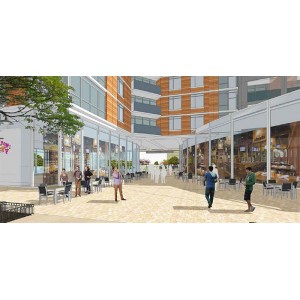Zoning Update Facilitates Mixed Use Development in Areas Already Planned for More Intensity
June 21, 2016
News Highlights
- Board of Supervisors authorized changes that will provide the zoning mechanism to implement some of the higher intensity mixed use recommendations already adopted as part of the county’s Comprehensive Plan.
- The new zoning law doesn’t grant automatic increases in development intensities. Properties must be rezoned, a process that includes public notice and public hearings before the Planning Commission and Board of Supervisors.
- The property is within a transit station area, community business center or commercial revitalization area.
To allow for planned mixed use development near Metro stations and older commercial areas, like Reston or Annandale, Fairfax County updated its zoning laws on Tuesday.
The
Board of Supervisors approved the zoning changes that will provide the zoning mechanism to implement some of the higher intensity mixed use recommendations already adopted as part of the county’s Comprehensive Plan. T
hese are specifically in places where the county’s land use plan already calls for a greater mix of homes, shops, and restaurants focused in lively, walkable environments.
Officials say the update was needed to align the county’s zoning laws with its land use plan. The ordinance regulates allowable development, and without the changes, the mixed use development recommended for certain areas can’t be considered through the rezoning process.
The change allows a maximum, 5.0 floor area ratio, a measure of development intensity, in specific areas. This FAR would only apply to planned commercial and planned residential mixed use districts if they are located in a transit station areas, community business centers or community revitalization districts.
Reston offers a good example. The county
approved greater development intensities two years ago for the areas around the four Silver Line stations. In some locations closet to the rail station, the land use plan calls for development intensities that can reach a 4.5 FAR, but the zoning law didn’t allow this for FAR until now.
Under the updated zoning law, the increased development intensities would be allowed only if:
- The property is within a transit station area, community business center or commercial revitalization area.
- The land use plan recommends a higher intensity at the specific property
- The property is rezoned based on an action by the Board of Supervisors following public notice.
Officials stress that the new zoning law doesn’t grant automatic increases in development intensities. Properties must be rezoned, a process that includes public notice and public hearings before the Planning Commission and Board of Supervisors.
The county is encouraging mixed use development near transit and older commercial areas to:
- Protect existing suburban neighborhoods
- Revitalize older commercial areas
- Create mixed use communities with easy access to transit that are increasingly desired by millennials to boomers
- Stimulate greater economic growth
By 2040, the D.C. area may add 2.1 million new residents based on regional forecasts. Fairfax County is estimated to grow the most with more than 287,300 new residents. Because of this anticipated growth, Fairfax, along with other localities, want to locate new housing and jobs in mixed use activity centers. The county’s land use plan clusters future commercial and housing development into these centers that make up about 10 percent of the land in the county.
The plan puts 99 percent of possible, future office, retail, hotel and industrial development in these centers, along with 83 percent of new housing.
This strategy protects existing suburban neighborhoods that make up most of the county—and it also helps to boost economic growth.
The zoning update
supports the county’s Economic Success Plan. In part, this plan calls for building dense, mixed-use, transit-oriented developments where people can live, work, shop and play.These projects attract more residents, jobs, and businesses.
These urban, walkable communities produce higher economic returns, according to academic research. The think tank Brookings looked at 201 walkable communities in the D.C. region, including Fairfax. Compared to suburban locations, researchers found that walkable places generated on average per square foot:
- $81.54 more in housing values
- $8.88 more in office rents
- $6.92 more in retail rents
- 80 percent more in retail sales
Increasingly, these communities are where everyone from millennials to baby boomers want to live. For example, 45 percent of Americans want to live where can easily walk to shops and restaurants, according to a national poll by the National Association of Realtors. This figure is even higher among millennials at 51 percent making this approach to future growth and development all the more important for Fairfax County.





















